Study Details:
Target Audience: Industry professionals whose companies’ primary business is in contracting, architecture, or dealing/distributing
Sample Source: Active, qualified subscribers to Walls & Ceilings, as well as a trusted third party sample partner.
Survey Method: Online
Where are we at in the industry? Are things better than they were 10 or five years ago? Is labor still a challenge? What is the industry to do about the supply chain shortage? What are the latest concerns contractors/architects/distributors have today?
The wall and ceiling industry has some great things going for it, yet still some challenges.
By John Wyatt
The purpose of the Walls & Ceilings State of the Industry Study is to identify current business conditions, trends and issues in the wall and ceiling industry.
Specifically, this research seeks to identify:
- Influential factors and key challenges facing the industry
- Change in product sales for 2021 and into 2022
- Company information including number of employees and gross annual 2021 sales
- Demographic profile of walls and ceilings industry professionals
-
Of the survey responses received, 68 percent are subcontractors; 24 percent architects; 2 percent distributors, and 7 percent others. Regionally, the survey was divided up into four regions: the West (including Alaska and Hawaii); South; Midwest, and Northeast.
The majority of commercial business revenue comes from new construction, while residential business revenue is split relatively evenly between new construction and repair/remodeling.
- Commercial new construction: 31 percent
- Commercial repair/remodeling: 22 percent
- Residential repair/remodeling: 23 percent
- Residential new construction: 20 percent
- Other: 4 percent
-
Business Conditions
Half of the respondents indicate business conditions are better in 2021 than in 2020 and more than half expect business conditions to be slightly or much better in 2022. For this year, 16 percent indicated business conditions are better; 33 percent say slightly better; 30 percent say about the same and 14 percent say slight worse.
Among the biggest concerns contractors face are the rising costs of materials next year.
Almost all respondents indicate the cost of doing business has increased in 2021 compared to 2020, and three-quarters expect the cost of doing business to increase in 2022.
This year, the cost of doing business compared to last year increased greatly says 62 percent of respondents; 34 percent says it increased slightly; 4 percent says it remained the same and 1 percent says it actually decreased.
Next year, the cost of doing business will increase greatly says 20 percent; 56 percent says it will increase slightly; 15 percent says it will remain the same and 9 percent says it will decrease slightly.
The majority of respondents indicated that material costs will continue to be a major issue. Respondents’ companies are also facing labor availability issues, supply chain issues, and labor cost issues, among other issues.
Training
Three quarters of respondents’ companies conduct in-house training, while 13 percent conduct little or no training. Field, design/build, and safety training are typically conducted in-house only.
Nearly one-third of respondents’ companies host manufacturer demos at their location at least once every quarter, while nearly half of respondents’ companies never host manufacturer demos. Forty seven percent says never; 2 percent says weekly; 13 percent monthly; 17 percent quarterly and 14 percent annually.
Sales
About half of companies expect 2021 sales to increase compared to 2020, with an average expected increase of 23 percent.
Company Annual Gross Sales
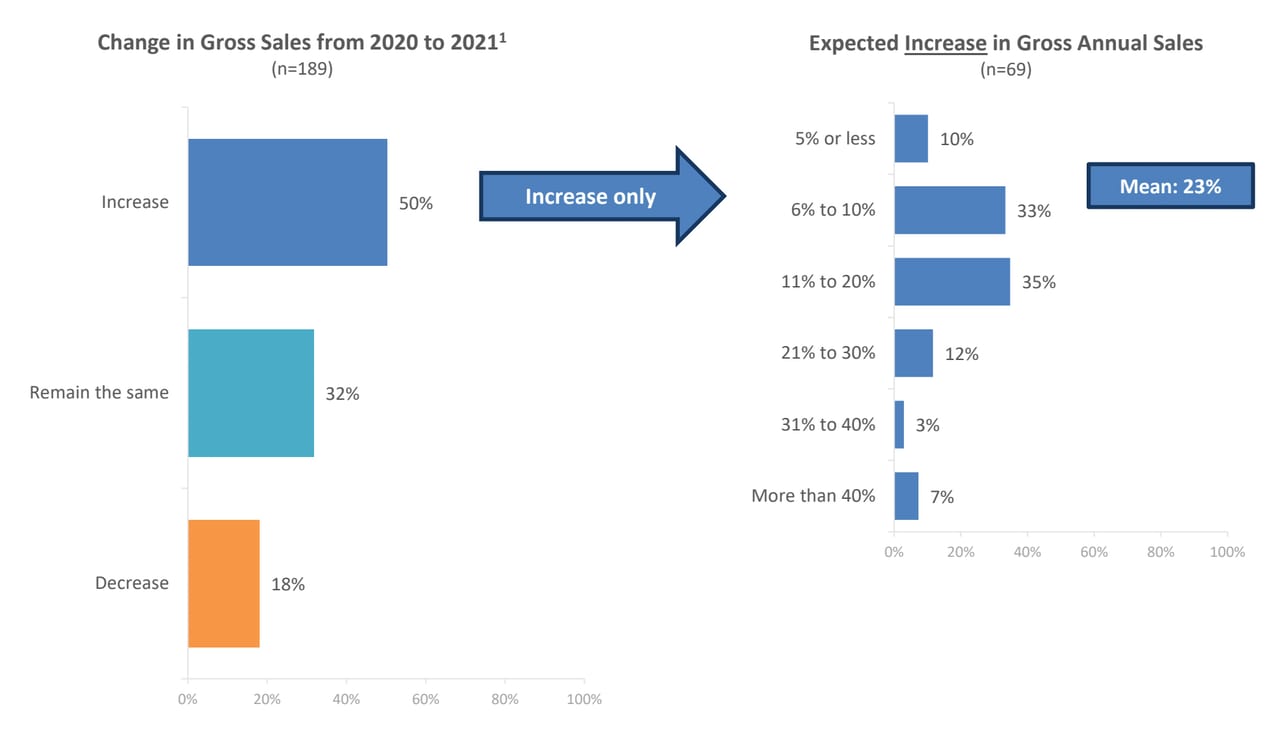
About half of companies expect 2021 sales to increase compared to 2020, with an average expected increase of 23%.
About half of companies expect 2021 sales to increase compared to 2020, with an average expected increase of 23%.
-
Almost all respondents indicated an increase in material pricing over the past 12 months (no surprise there). Overwhelmingly, 81 percent says that material costs have increased significantly; 16 percent says they have increased somewhat; 2 percent says they remained the same, and 1 percent says they have decreased somewhat.
Employee Information
On average, responding companies have a mean of 81 full-time employees and 5 part-time employees. Nearly half of companies do not have part-time employees. Nearly half of respondents indicate the number of employees at their company in 2021 has remained the same compared to 2020, however, 44 percent believe that in 2022 the number of employees at their company will increase.
Change in Number of Employees

Nearly half of respondents indicate the number of employees at their company in 2021 has remained the same compared to 2020, however, 44% believe that in 2022 the number of employees at their company will increase.
Nearly half of respondents indicate the number of employees at their company in 2021 has remained the same compared to 2020, however, 44% believe that in 2022 the number of employees at their company will increase.
Over half of the respondents agree the future of the “specialty contractor” is promising, expect to see a significant shift in how they build, and are moving towards using more prefabricated systems.
Future of the Industry
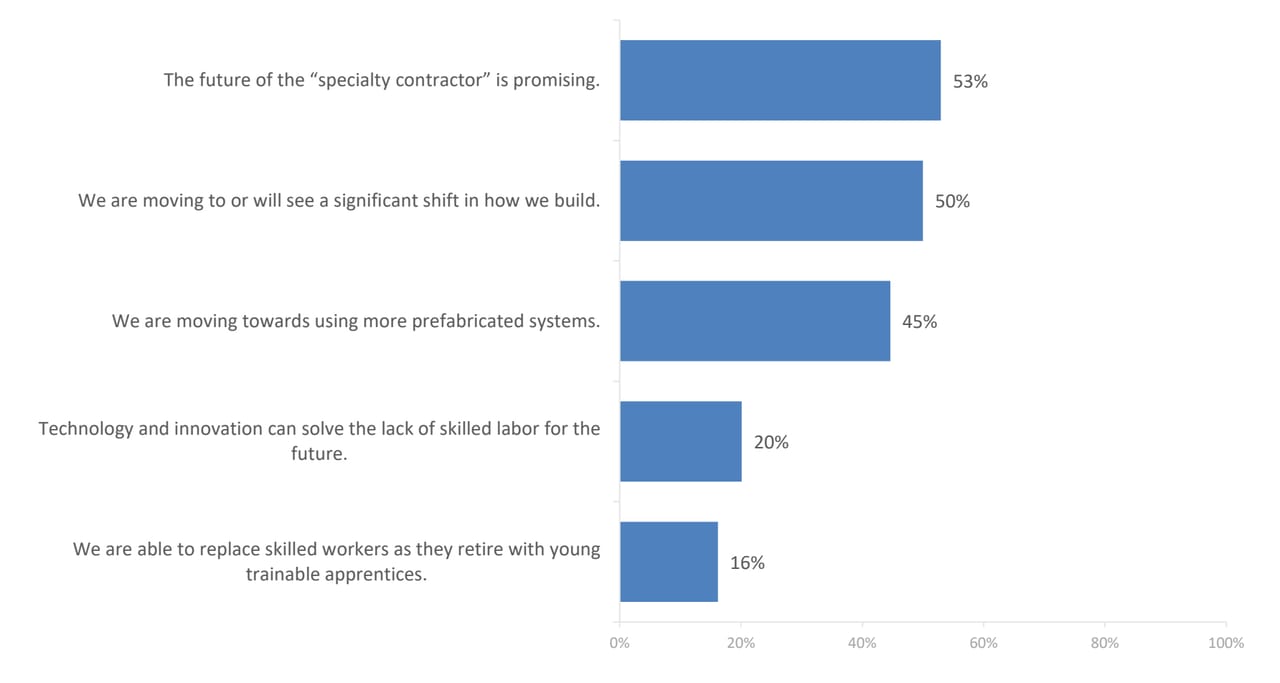
About half of respondents agree the future of the “specialty contractor” is promising, expect to see a significant shift in how they build, and/or are moving towards using more prefabricated systems.
About half of respondents agree the future of the “specialty contractor” is promising, expect to see a significant shift in how they build, and/or are moving towards using more prefabricated systems.
To combat the labor shortage—among other issues—one-third or more of companies have increased current employee duties/responsibilities, increased current employee hours, gave out referral bonuses, and/or sought out new employees via job boards to help correct the lack of workers.
Industry Opinions and Actions
Material costs, supply chain, economic conditions, and finding qualified workers are expected to be the most influential factors in 2022.
Influential Factors for 2022
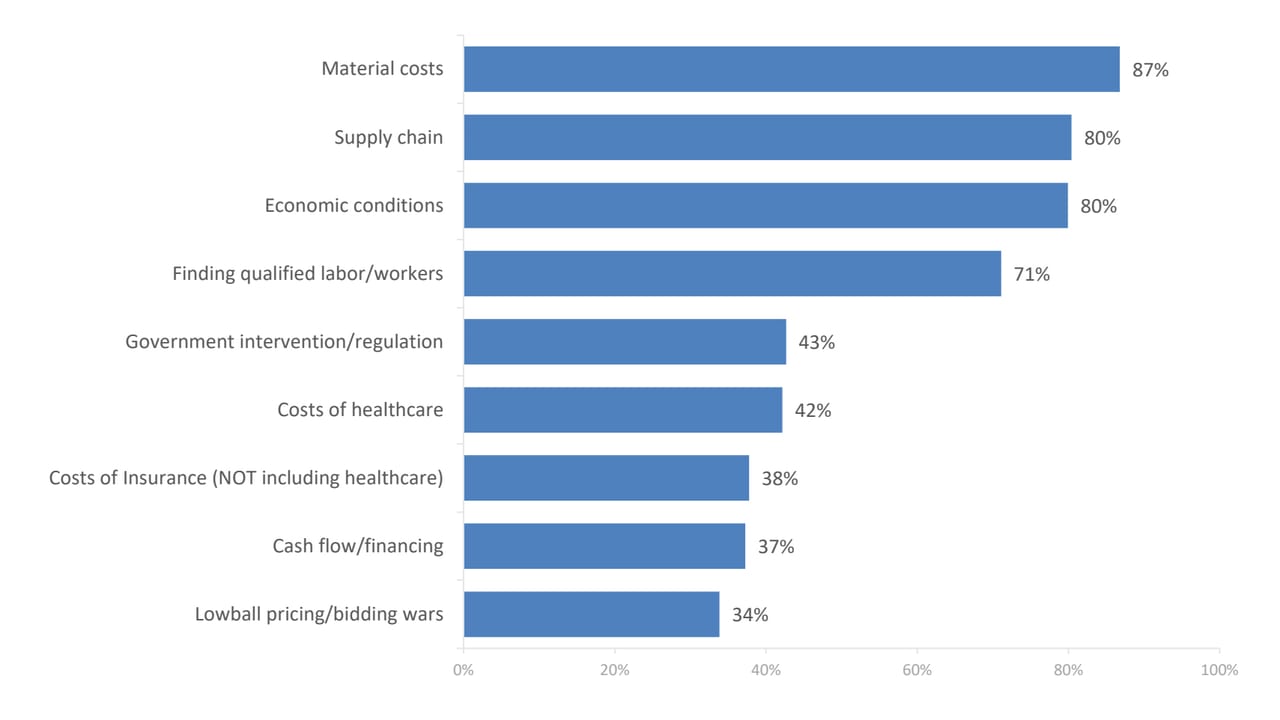
Material costs, supply chain, economic conditions, and finding qualified workers are expected to be the most influential factors in 2022.
Material costs, supply chain, economic conditions, and finding qualified workers are expected to be the most influential factors in 2022.
Labor issues are most likely to be the greatest challenge for companies within the wall and ceiling industry in 2022. Respondents suggest controlling costs, education/training, and achieving quality work to ensure their businesses have a profitable and successful future. (See Industry Opinions sidebar for more elaboration.)
Industry Opinions
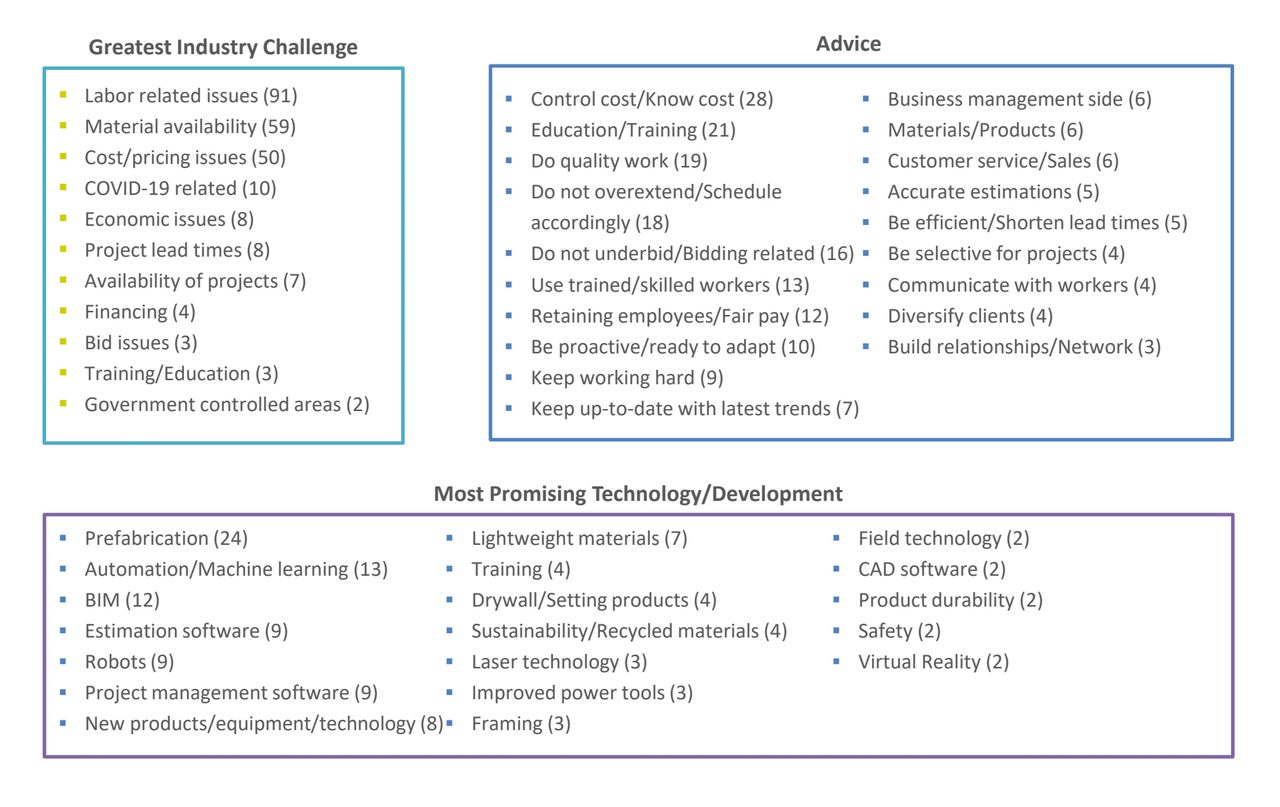
Labor issues are most likely to be the greatest challenge for companies within the wall and ceiling industry in 2022. Respondents suggest controlling costs, education/training, and achieving quality work to ensure business have a profitable and successful future.
Labor issues are most likely to be the greatest challenge for companies within the wall and ceiling industry in 2022. Respondents suggest controlling costs, education/training, and achieving quality work to ensure business have a profitable and successful future.
Greatest Industry Challenge
- Labor related issues
- Material availability
- Cost/pricing issues
- COVID-19 related
- Economic issues
- Project lead times
- Availability of projects
- Financing
- Bid issues
- Training/Education
- Government controlled areas
Advice
- Control cost/Know cost
- Education/Training
- Do quality work
- Do not overextend/Schedule accordingly
- Do not underbid/Bidding related
- Use trained/skilled workers
- Retaining employees/Fair pay
- Be proactive/ready to adapt
- Keep working hard
- Keep up-to-date with latest trends
Most Promising Technology/Development
- Prefabrication
- Automation/machine learning
- BIM
- Estimation software
- Robots
- Project management software
- New products/equipment/technology
- Lightweight materials
- Training
- Drywall/Setting products
- Business management side
- Materials/Products
- Customer service/Sales
- Accurate estimations
- Be efficient/Shorten lead times
- Be selective for projects
- Communicate with workers
- Diversify clients
- Build relationships/Network
- Sustainability/recycled materials
- Laser technology
- Improved power tools
- Framing
- Field technology
- CAD software
- Product durability
- Safety
- Virtual Reality
Demographics
For those that participated in this survey, 87 percent were male and 13 percent female. More than 60 percent of those surveyed were between the ages of 50 to 69 years old with only 10 percent under the age of 39. Respondents’ job duties are broken down as:
- Corporate Executive/Management: 51 percent
- General Management: 26 percent
- Architecture/Design: 20 percent
- Installation/Technician/Maintenance: <1 percent
- Other: 2 percent
-
Respondent Purchaser Influence
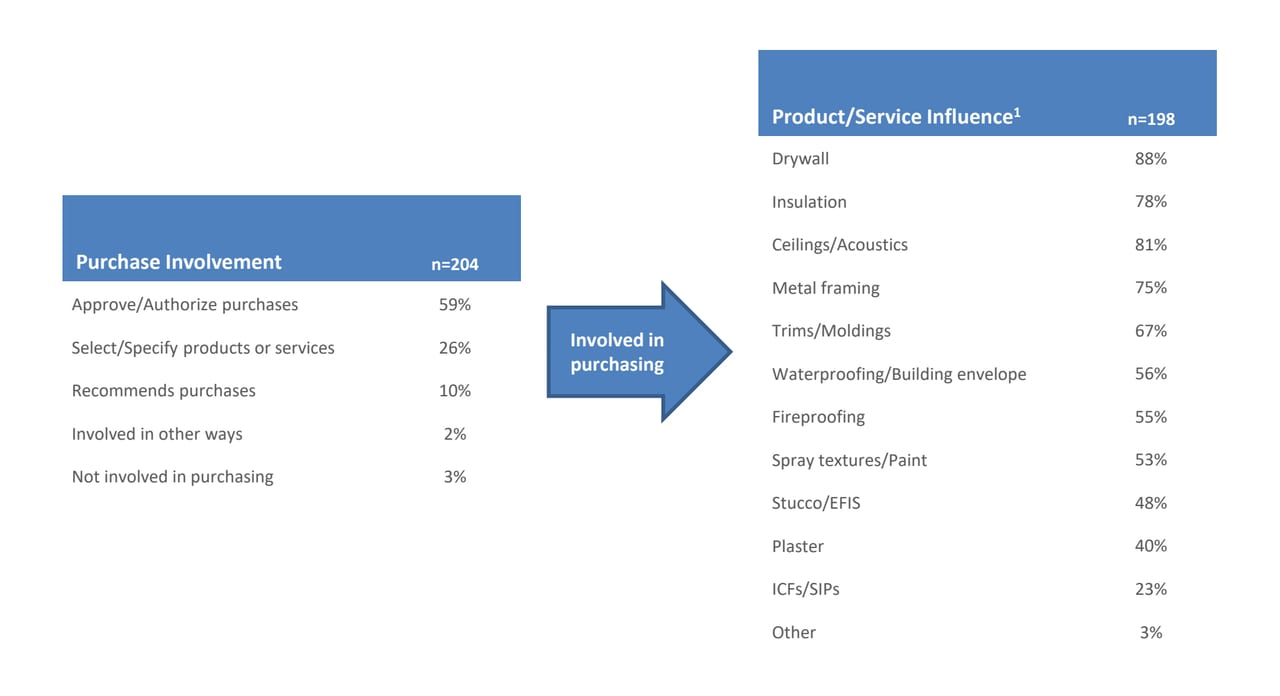
Conclusion
In short, many of the same problems still exist as they did when we last conducted our State of the Industry study in 2019. These include the material costs, estimating/bidding, labor issues among those. But without a doubt, COVID-19 has very much so amplified an already lacking skilled labor workforce and the supply chain issue will get worse before it gets better. Many companies are operating with a much smaller field staff than in previous years.
But with new technologies and products, there are new opportunities. Many contractors have discovered niche services and more education in regards to construction software, including Design-Build platforms. And further good news reflects that many wall and ceiling contractors have a backlog taking them from three quarters to a full year. One thing’s for sure: 2022 will be an interesting year.
Industry Professionals Speak
2022 will no doubt bring its challenges to us, but we look forward to 2022 with cautious optimism.




